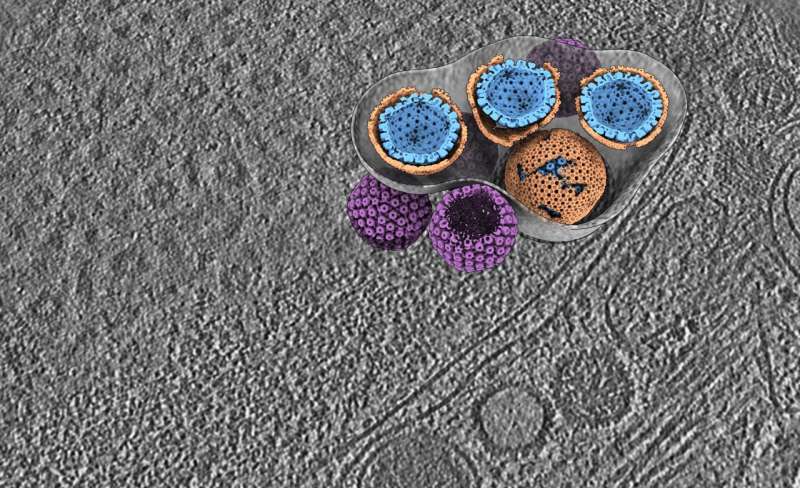This article has been reviewed according to Science X's editorial process and policies. Editors have highlighted the following attributes while ensuring the content's credibility:
fact-checked
peer-reviewed publication
proofread
Key mechanism of herpesvirus egress uncovered, offering new target for antiviral therapies

An international team of researchers, led by the Leibniz Institute of Virology (LIV), have uncovered crucial details on how herpesviruses exit the cell nucleus without compromising the integrity of the nuclear envelope. Herpesvirus infections are widespread globally and cause significant health burdens and life-threatening complications in immunocompromised people.
The study, published on June 25 in Nature Microbiology, utilized advanced electron cryo-tomography to visualize the structures involved. These findings could pave the way for developing more effective antiviral therapies to combat herpesvirus infections.
The new study focuses on Herpes simplex virus 1—the causative agent of oral cold sores—and Pseudorabies virus (PrV), a model virus for human herpes infections. The researchers identified various structures of the herpesviral nuclear egress complex (NEC) protein coat located on the inner nuclear membrane. These structures are critical for the release of capsids into the cytosol, where they can acquire the envelope before leaving the cell.
The researchers use advanced imaging techniques, such as electron cryo-tomography, to structurally characterize the interface between the NEC and the transported virus capsid surface in infected cells.
These nanoscale insights reveal that the NEC plays a key role in shuttling herpesvirus capsids—the icosahedral protein cages that contain the herpesviral DNA genome—from the nucleus without damaging the nuclear envelope. The findings indicate a remarkable structural flexibility of the NEC, suggesting that the mechanism is not rigid but adaptive.
Dr. Vojtěch Pražák, Postdoctoral Fellow in the department Structural Cell Biology of Viruses at LIV and one of the study's lead authors states, "How do you pass a ball through a double glazed window without breaking it? We can't do it, but herpesviruses figured out how to do the equivalent—to go through the nuclear membranes without rupturing them. This is a really useful skill for them since a damaged nucleus would tell the immune system something is wrong."
"Our work shows that the NEC coat formation happens in distinct steps. We were also surprised to the extent the individual NEC components can flex to form different 3D structures, rather than a single uniform lattice," explains Yuliia Mironova, Graduate Student in the department Structural Cell Biology of Viruses at LIV and another lead author of the study. "The detailed characterization of these processes may open new avenues for targeted disruption of virus replication."
Previous studies highlighted the importance of the NEC for the viral life cycle, but this study provides the first detailed structural analysis of the NEC-virus particle interfaces in the cellular environment.
Prof. Dr. Kay Grünewald, Head of the LIV department Structural Cell Biology of Viruses and Deputy Scientific Director of the Center for Structural Systems Biology, emphasizes, "We investigated how proteins interact in NEC structures of different curvature in cells and thus identified the flexibility of these interactions. This allowed us to show how local nuclear membrane protrusion is induced. Surprisingly, we also found that the interaction between capsid and NEC is not restricted to specific positions on the capsids."
Overall, the new insights from this study offer promising perspectives for combating herpesvirus infections. The nanoscale structural insights determined by the researchers lay the foundation for understanding the complex nuclear egress mechanism common to all herpesviruses. Accordingly, the results are also relevant for other human-pathogenic herpesviruses, thus providing exciting starting points for developing antiviral interventions.
Herpesviruses replicate their DNA within the nucleus of infected cells. After replication, the genome is packed into newly assembled virus capsids, i.e., icosahedral protein containers of about 125 nm diameter. These then exit the nucleus to reach the cytosol of the cell to undergo final assembly and envelopment and are eventually released from the cell.
Released virus particles can invade neighboring cells, breaching the cell membrane by membrane fusion. Besides epithelial cells, neurons are also infected. In the latter, herpesviruses can establish lifelong persistent infections, termed latency. During latency, no infectious virus is produced from infected cell. This makes them inaccessible to antiviral drugs. Upon stress or other triggers like UV-light infections can reactivate.
The Pseudorabies virus (PrV) was used in the study as a model virus to investigate the nuclear egress mechanisms of herpesviruses. Herpesviruses share many fundamental mechanisms and structures, so insights gained with PrV are often transferable to other herpesviruses. This includes human-pathogenic herpesviruses such as the herpes simplex viruses 1 (HSV-1, here studied as well) and 2 (HSV-2), which can cause cold sores and genital herpes, respectively, and the varicella-zoster virus (VZV), which causes chickenpox and shingles.
Currently, there are only few types of antiviral medications available to treat herpesvirus infections. These can alleviate symptoms and shorten the duration of the infection but are unable to completely eliminate the virus from the body. Therefore, a need for new therapies remains to more effectively combat resistance against the available set of antivirals. This is not only relevant to improve the quality of life for any herpesvirus affected persons but particularly important for immunocompromised individuals, where herpesvirus infection can be life threatening.
More information: Vojtěch Pražák et al, Molecular plasticity of herpesvirus nuclear egress analysed in situ, Nature Microbiology (2024). DOI: 10.1038/s41564-024-01716-8
Journal information: Nature Microbiology
Provided by Leibniz-Institut für Virologie (LIV)





















